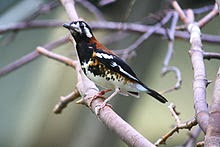 |
| Chestnut-backed Thrush |
The last of the passerines currently on show at Bristol Zoo is the Chesnut-backed thrush,
Geocichla dohertyi. A native of the Lesser Sunda islands, Lombok, and Timor in Indonesia, it is already extinct on Lombok and is declining, mainly as a result of deforestation and local bird trapping, in the rest of its range. As a result it is classed by the IUCN as Near Threatened, and the wild population is estimated at around 25,000 individuals. The captive population, both in zoos worldwide and in private hands, is probably under 200.
 |
| G.citrina - India |
The Chestnut-backed thrush is just one of a group of over 20 similar species of geocichla found throughout India and SE Asia. Formerly placed in
Zoothera, they have now been split off into a separate genus.
Zoothera in now restricted to a group of 14 or so, mostly larger species, found from Siberia through to Africa. Two American species (Varied and Aztec Thrushes) are not now included in Zoothera. Many of the more northerly species of both
Geocichla and
Zoothera are migratory, travelling to SE Asia, India, or Africa for the winter.
 |
| G.siberica - Siberia |
In behaviour, it is a fairly typical thrush. It often feeds on the ground on various invertebrates (snails are especially important to females when nesting as their shells provide calcium), but will feed on seasonal fruits of suitable size as well. As with other rainforest frugivores, it is an important seed disperser. It prefers primary rainforest at elevations below 1700m, and unfortunately this is also the major area of deforestation, further impacting the species.
In captivity various zoos and private individuals have bred these birds. The nest is a typical cup-shaped nest, fairly substantial and often incorporating mud, and the clutch is usually around 3-4 eggs. As with most passerines, live food is essential to raising the young, and the commercial production of earthworms as live food has greatly improved breeding success with many species of thrushes in recent years. Lifespan is not clear, but going by other similar species it may reach up to 10 years in some individuals, at least in captivity.
This brings to an end the series on passerines. Next week, highlights of a recent birding trip to Bulgaria – Pelicans, Vultures, and various butterflies.
(images from wikipedia).



No comments:
Post a Comment